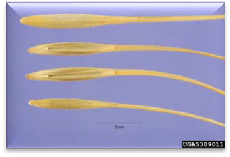Also Known As: medusahead rye, medusahead grass, medusa’s head
Medusahead (Taeniatherum caput-medusae (L.) Nevski), is a cool-season annual grass native to the Mediterranean region. Plants grow from 8 inches to 2 feet tall, depending on the site. Stems are wiry and slender. Medusahead produces tillers but few leaves. The leaf blades are somewhat rolled and are generally no more than 1/8 inch wide. Flowering occurs in late spring. The inflorescence contains 2 to 3 spikelets per node. The longer of 2 awns in each spikelet contains upward pointing barbs. Awns are straight when green, but twist as they dry in a “snake-like” fashion reminiscent of the mythological medusa head. Because medusahead matures several weeks later than most other annual grasses, its green color stands out against a backdrop of brown grasses. As the plant matures, it turns purple and eventually light gray or tan. Medusahead is sometimes confused with foxtail barley or squirreltail, but can be distinguished by a seed head that does not break apart as seeds mature. Medusahead has a fibrous root system that depletes upper soil moisture early in the season and extracts deep soil moisture later in the season. Medusahead reproduces by seed, and seed production is prolific. Seed is dispersed by wind, water and by moving objects to which the barbed awns adhere.
backdrop of brown grasses. As the plant matures, it turns purple and eventually light gray or tan. Medusahead is sometimes confused with foxtail barley or squirreltail, but can be distinguished by a seed head that does not break apart as seeds mature. Medusahead has a fibrous root system that depletes upper soil moisture early in the season and extracts deep soil moisture later in the season. Medusahead reproduces by seed, and seed production is prolific. Seed is dispersed by wind, water and by moving objects to which the barbed awns adhere.
Soils with high clay content are most susceptible to medusahead establishment. The plant commonly invades rangeland communities. It is extremely competitive and often forms dense stands, usually more than 100 plants/ft2. Medusahead is of great concern to the range livestock industry because it can severely reduce grazing capacity (up to 75%) by suppressing desirable vegetation. Because of its high silica content, medusahead is unpalatable to livestock and wildlife except during early growth stages. Although livestock will eat medusahead in the spring and when other feed is limited, it has low feed value. The stiff awns and hard florets can injure the eyes, noses and mouths of grazing animals. The silica-rich medusahead plants are slow to decompose and form a persistent litter layer on the soil surface.
Photo by: Joseph M DiTomaso, University of California-Davis, Bugwood.org
Control Methods
Mechanical: Medusahead is virtually impossible to eradicate using mechanical control methods alone. Disking and plowing before seed set can be effective, particularly if followed by chemical spot treatments and revegetation. Tillage can be used to manage medusahead plants and break up deep thatch layers.
Prescribed Fire: Prescribed fire has reportedly been effective when medusahead stands are burned using a slow, hot fire after seeds have ripened but before they have fallen. The optimal time for a burn is the “soft dough” stage, i.e., seeds exude a milky substance when squeezed. Because prescribed fire has the potential to exacerbate infestations, this control method should be used cautiously.
Chemical: Herbicides can be effective, particularly when used in conjunction with other control measures. Glyphosate applied in early spring before seed production can be used for control. This chemical will injure other vegetation, so labels must be followed and caution used. Imazapic can be very effective for the control of medusahead. An integrated management approach will be needed to control this weed (e.g., fire, imazapic, revegetation).
More information can be found in the PNW Weed Management Handbook
USE PESTICIDES WITH CARE. Apply them only to plants, animals, or sites listed on the label. When mixing and applying pesticides, follow all label precautions to protect yourself and others around you. It is a violation of the law to disregard label directions. Store pesticides in their original containers and keep them out of the reach of children, pets, and livestock.
Biological: Insect biological control agents are not now available, nor are they imminent. Grazing can be used in an integrated management plan if livestock (cattle, sheep) are used to graze medusahead early in the season, before the plant becomes unpalatable. Control through grazing is extremely difficult and limited for medusahead.
Questions: contact Steve Van Vleet or phone (509) 397 – 6290
Photo credits included in PDF



